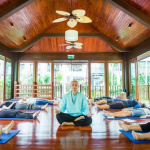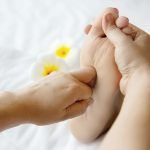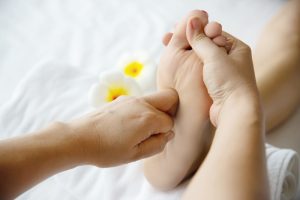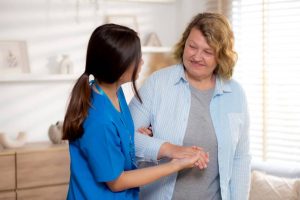Aging feet carry a lifetime of miles, and they start telling the story. Common foot problems in older adults, or “Problemas Comunes De Los Pies,” include bunions, corns, neuropathy, swelling, and stubborn wounds that won’t heal quickly. The good news: small, consistent habits and smart footwear can prevent most setbacks. If reading on a phone, consider this your quick guide, tap here mentally to jump from awareness to action. Below, they’ll find clear ways to spot issues early, improve circulation, choose better shoes, build a safer at‑home routine, and know when it’s time to call a specialist.
Identifying age-related conditions such as bunions, corns, and neuropathy
Bunions, corns, and neuropathy often creep up gradually, so early recognition matters.
Bunions (Hallux Valgus)
- What they are: A bunion forms when the big toe angles toward the second toe, creating a bony bump at the base joint. Genetics, years of narrow footwear, and arthritis accelerate the shift.
- What it feels like: Aching at the big toe joint, redness, swelling, and difficulty finding comfortable shoes. Pain typically worsens with tight toe boxes or prolonged standing.
- Why older adults are at risk: Ligaments and joint cartilage naturally loosen or wear with age, and cumulative footwear choices compound the issue.
- What helps now: Wider toe boxes, low heels, cushioned insoles, bunion pads, toe spacers, and targeted foot strengthening (like big-toe presses and towel scrunches). Surgery is an option for severe pain or deformity impacting quality of life.
Corns and Calluses
- What they are: Thickened skin from friction or pressure. Corns tend to be conical and sore to the touch: calluses are broader and often painless until they crack.
- Triggers: Ill‑fitting shoes, hammertoes, bunions changing foot mechanics, and dry skin.
- Why older adults are at risk: Fat pads under the forefoot and heel thin with age, increasing pressure on bony areas.
- What helps now: Correct shoe fit, moisture‑balancing creams (look for 10–20% urea), gentle pumice use, and addressing the underlying pressure point, often with insoles or orthotics.
Peripheral Neuropathy
- What it is: Nerve damage causing numbness, tingling, burning, or loss of protective sensation, commonly linked to diabetes, B12 deficiency, alcohol use, chemotherapy, and spinal issues.
- What it feels like: Pins-and-needles, night pain, or feeling like socks are bunched when they aren’t. Some feel nothing at all, which raises injury risk.
- Why it matters: Loss of sensation means cuts, blisters, or hot spots go unnoticed and can turn into infections or ulcers.
- What helps now: Optimizing blood sugar, checking feet daily (including between toes and under the forefoot), wearing protective shoes, even indoors, and asking a clinician about neuropathy meds, vitamin status, and physical therapy for balance.
A quick self-check: If a partner or caregiver can lightly touch the bottom of the great toe and forefoot with a cotton swab and they can’t reliably tell where, it’s time to discuss neuropathy screening.
How circulation issues contribute to delayed foot-wound healing
Healing is a team sport, blood flow delivers oxygen and nutrients, while veins and lymphatics clear waste. When circulation lags, even a small blister can stall.
Peripheral Arterial Disease (PAD)
- What it is: Plaque narrows arteries in the legs and feet, reducing blood supply.
- Clues to watch: Calf pain when walking that eases with rest (claudication), cool or pale feet, slow-growing nails, shiny skin, and wounds that don’t progress after two weeks.
- Why it delays healing: Less oxygen means slower tissue repair and higher infection risk.
- What helps: A walking program approved by a clinician, smoking cessation, cholesterol and blood pressure management, and, in some cases, supervised exercise therapy or revascularization procedures.
Venous Insufficiency and Edema
- What it is: Veins struggle to return blood upward, causing pooling and swelling around the ankles and lower legs.
- Signs: Puffiness by evening, skin discoloration (brownish), itching, and weeping skin. Wounds near the medial ankle are common and slow to heal.
- What helps: Leg elevation, calf-pump exercises (ankle circles, heel-to-toe rocking), compression socks selected with clinician input (especially if PAD is suspected), and consistent skin moisturization to prevent cracking.
Diabetes and Microvascular Changes
- Why it matters: Elevated blood glucose stiffens small vessels and impairs immune function. This is why people with diabetes experience more foot ulcers and infections.
- Practical steps: Daily foot checks, tight glucose control, and avoiding barefoot walking. Even indoors, a supportive slipper or house shoe reduces injury risk.
A simple rule of thumb: If a cut, blister, or sore doesn’t look better after 7–10 days, or looks worse, assume circulation or infection may be involved and seek care promptly.
Footwear design essentials for balance and joint support
The right shoe is quiet medicine. Design details can stabilize joints, reduce pressure points, and prevent falls.
Fit and Shape
- Wide, anatomical toe box: To accommodate bunions, hammertoes, and natural toe splay. Toes shouldn’t rub: they should wiggle.
- Depth and adjustability: Extra‑depth uppers and adjustable straps or laces help fit orthotics and swelling throughout the day.
Stability Features
- Firm heel counter: Pinch the back, if it collapses easily, it won’t stabilize the heel.
- Midfoot support: Moderate torsional rigidity (twist resistance) controls excessive motion that aggravates plantar fasciitis and arthritis.
- Rocker sole: A slight rocker helps roll from heel to toe, offloading forefoot joints, useful for bunions, hallux rigidus, and metatarsal pain.
Cushioning and Pressure Relief
- Dual‑density midsoles: Softer under the heel and forefoot, firmer through the arch to guide motion.
- Removable insole: Makes room for custom orthotics or off‑the‑shelf arch supports. Look for top covers that reduce shear.
Traction and Fall Prevention
- Grippy outsole: Fine tread that works on wet sidewalks and indoor floors without catching.
- Low, stable heel: Around 0.5–1 inch drop keeps the ankle from pitching forward while maintaining natural gait.
Practical buying tips
- Shop later in the day when feet are slightly swollen to avoid too‑tight fits.
- Bring or wear the socks they’ll use most.
- Try the “thumb test”: About a thumb’s width (3/8–1/2 inch) from the longest toe to the shoe end.
- Walk on a hard surface in-store: listen for slapping (often too loose) or rubbing (hot spots). If a brand offers a “wide” or “extra wide,” try it first for bunions.
Good shoes don’t fix everything, but they reduce the daily strain that makes “Problemas Comunes De Los Pies” flare.
At-home care routines reducing infection and callus formation
Consistency beats intensity. A five‑minute routine, repeated most days, protects skin and nails and catches problems early.
Daily
- Quick inspection: Top, sole, heel, between toes. Look for redness, cracks, blisters, drainage, or areas that feel warmer than the rest.
- Wash and dry well: Lukewarm water, mild soap. Pat dry between toes to prevent fungal growth.
- Moisturize, except between toes: Use a cream with urea, lactic acid, or ceramides on heels and callused areas. Skip the spaces between toes to avoid maceration.
- Sock smart: Choose breathable, moisture‑wicking socks: change damp socks promptly. Seamless socks can prevent rubbing over bunions and hammertoes.
2–3 times per week
- Gentle callus care: After a bath or shower, lightly use a pumice stone on thickened areas. Stop if it hurts or skin becomes pink or shiny. Never use bathroom razors or callus “shavers.”
- Toe and ankle mobility: Alphabet ankle movements, towel scrunches, and calf stretches keep joints supple and improve circulation.
Weekly
- Nail care: Trim straight across with clean clippers: use an emery board to smooth edges. If nails are thick, curved, or hard to reach, a podiatry visit prevents injury.
- Footwear audit: Check insoles for wear, shoes for creases or uneven outsole wear that create pressure points.
Infection prevention mindset
- Treat small issues early: A small blister? Clean with mild soap and water, apply a sterile bandage, and monitor daily.
- Athlete’s foot: Itchy, peeling skin, especially between toes, often responds to over‑the‑counter antifungal creams used for 2–4 weeks. Keep going one week after symptoms resolve.
- Red flags: Spreading redness, warmth, pus, fever, a foul odor, or black/discolored tissue warrant urgent care.
Caregivers can help by setting a recurring reminder for a weekly foot check. Five minutes now can save weeks of healing later.













Add Comment